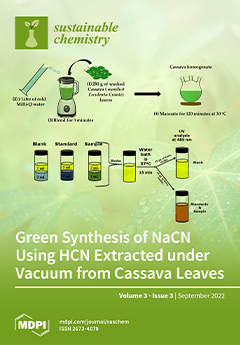Ionic liquids (ILs) are a potential solution to the general problem of low solubility, polymorphism and low bioavailability of active pharmaceutical ingredients (APIs). In this work, we report on the synthesis of three pharmaceutically active ILs (API-ILs) based on ibuprofen, one of the
[...] Read more.
Ionic liquids (ILs) are a potential solution to the general problem of low solubility, polymorphism and low bioavailability of active pharmaceutical ingredients (APIs). In this work, we report on the synthesis of three pharmaceutically active ILs (API-ILs) based on ibuprofen, one of the most commonly available over-the-counter nonsteroidal anti-inflammatory drugs (NSAIDs), with imidazolium cations ([C
2C
1Im][Ibu] and [C
2(OH)C1Im][Ibu]) and a cholinium cation ([N
1112(OH)][Ibu]). An upgrade to the aqueous solubility (water and biological simulated fluids) for the ibuprofen-based ILs relative to the ibuprofen’s neutral and salt form (sodium ibuprofen) was verified. The cytotoxic profiles of the synthesized API-ILs were characterized using two human cells lines, Caco-2 colon carcinoma cells and HepG-2 hepatocellular carcinoma cells, up to ibuprofen’s maximum plasma concentration (C
max) without impairing their cytotoxicity response. Additionally, the EC
50 in the Caco-2 cell line revealed similar results for both parent APIs and API-ILs. The biocompatibility of the ibuprofen-based ILs was also evaluated through a hemolytic activity assay, and the results showed that all the ILs were hemocompatible at concentrations higher than the ibuprofen C
max. Moreover, the anti-inflammatory properties of the API-ILs were assessed through the inhibition of bovine serum albumin (BSA) denaturation and inhibition of cyclooxygenases (COX-1 and COX-2). The results showed that [C
2C
1Im][Ibu], [C
2(OH)C1Im][Ibu] and [N
1112(OH)][Ibu] maintained their anti-inflammatory response to ibuprofen, with improved selectivity towards COX-2, allowing the development of safer NSAIDs and the recognition of new avenues for selective COX-2 inhibitors in cancer chemotherapy and neurological diseases such as Alzheimer’s and Parkinson’s.
Full article




